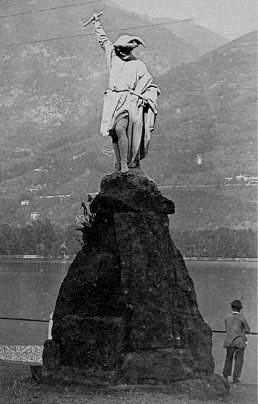Vincenzo Vela e la Svizzera
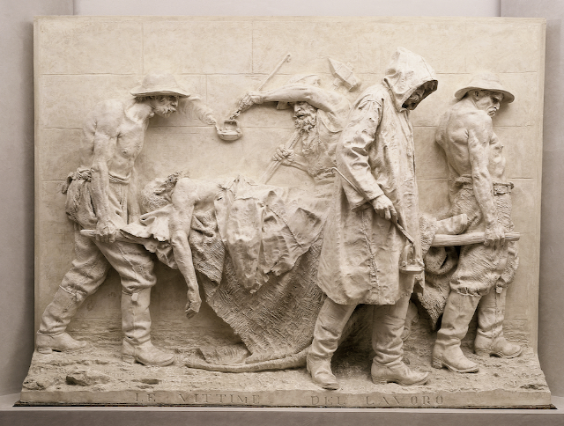
The “apse” of the museum contains a series of works that relate to the events, figures and republican ideals in Switzerland, his homeland. The objects displayed include portrait busts of famous individuals, and preparatory models for – or replicas of – political and civic sculptures, which were dear to Vela, the "militant" artist. It was his wish that his work would bear on the historical events of his lifetime. The expressive and ideal culmination of this stance was the relief of The Victims of Labour, a plastic work of the early 1880s of major importance for the consequences it had, both ideological and formal, on the sculpture of Italy and Europe in the nineteenth century and later.
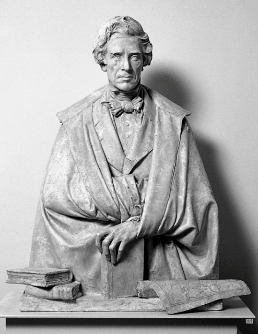
Vincenzo Vela, the most famous Ticinese sculptor of the period, was invited to commemorate one of the fathers of the canton's modern identity, Stefano Franscini (1796-1857), an intellectual and liberal politician dedicated to establishing secular public education. The half-figure portrait unusually shows him face-on, wrapped in a cloak, the element that defines the composition. The attributes he has been given, books and parchment rolls, are descriptive of Franscini's mission in life.
Marble, 1860, Lugano, Liceo Cantonale
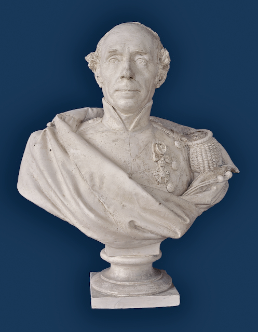
A commander of the Swiss federal troops, as a general in the Sonderbund civil war (autumn 1847), Guillaume-Henri Dufour (1787-1875) distinguished himself for his strategic thinking and far-sighted policies, becoming a heroic and almost legendary figure to the Swiss Confederation. The young Vincenzo Vela was commissioned by the administration of the Canton Ticino, which had awarded Dufour with an honorary citizenship, to portray the general in marble. The work was produced working directly with the subject and the restrained idealisation apparent in the work renewed the mutual esteem and friendship that existed between the general, a defender of the confederate spirit, and the sculptor, who had responded to the threat of the Sonderbund by enrolling as a volunteer to defend the unity of the Confederation.
Marble, 1849, Bellinzona, Palazzo del Governo
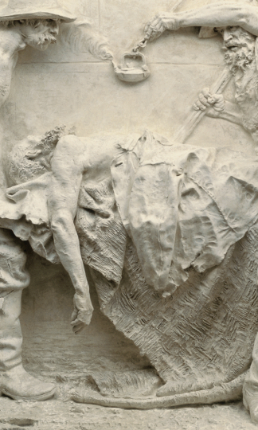
"...I made this work without receiving a commission or the idea from anyone..." claimed Vela in a letter in 1886, revealing the fully personal origin of this highly progressive chapter in the artist's oeuvre. Having regained his confidence after the defeat he suffered with the Brunswick Mausoleum, and living in Canton Ticino where it was impossible not to be aware of the current and triumphal reporting of the digging of the St Gotthard railway tunnel, Vela, now sixty years of age, produced this striking high relief, one of the first monuments to be erected in Europe dedicated to the "working class" and to the sacred dignity of human labour.
The scene shows two miners as they carry one of their dying companions out of the tunnel on a stretcher, and two other miners, mute witnesses to the tragedy.
The uncompromising and strongly sculptural modelling, which verges on the limit of expressionist deformation, illustrates the drama of the project through solemnity and formality, transcending the glory of the endeavour trumpeted by the press. The work immediately became a powerful vehicle for the social and humanitarian values that Vela championed.
Bronze, 1893, Rome, Galleria Nazionale d'Arte Moderna;
bronze, 1932, Airolo, railway station
The monument to William Tell was commissioned by Giacomo Ciani, a politically liberal and eminent banker, patriot and patron of the arts. He was very active in the civil and political battles in Ticino but equally so in those in Lombardy under Austrian rule. Unshakable in his defence of liberty, the legendary and popular Swiss hero stands with his crossbow on a rock that symbolises the mountains of Switzerland, raising two bolts to represent challenge and victory. Originally the statue was placed on the lakeside in front of the Hotel du Parc facing away from the lake towards the mountains of Switzerland to confirm the loyalty of the canton of Ticino to a confederation that stood for independence and freedom.
Stone, 1856, Lugano, Riva Albertolli (ex Lugano, Riva Tell)
